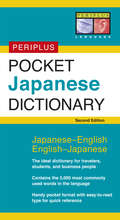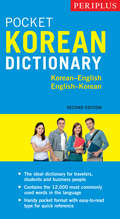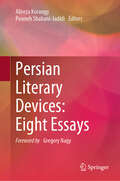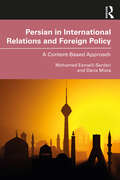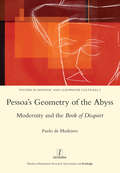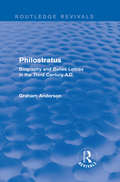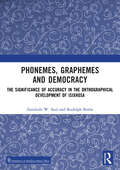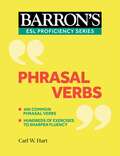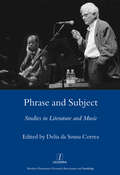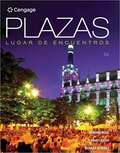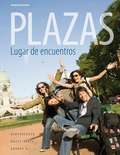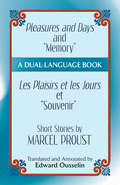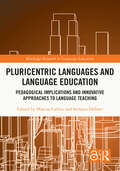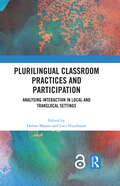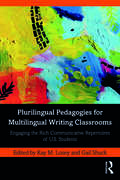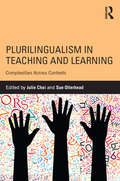- Table View
- List View
Periplus Pocket Japanese Dictionary
by Yuki ShimadaPeriplus Pocket Japanese Dictionary is ideal for students and travelers, covering all the words needed for everyday situations and travel basics without confusing abbreviations or dictionary terminology. The dictionary is bi-directional and features over 4,500 entries.
Periplus Pocket Japanese Dictionary: Japanese-English English-Japanese Second Edition
by Yuki Shimada Taeko TakayamaIt's never a good idea to be overly-relient on technology while traveling! Look up words quickly and easily with this great travel-sized Japanese dictionary.Intended for use by tourists, students, and businesspeople traveling to Japan, Pocket Japanese Dictionary is an essential tool for communicating in Japanese and a great way to learn Japanese. It's handy pocket format and easy-to-read type will make any future trip to Japan much easier. In addition to being an excellent English to Japanese and Japanese to English dictionary, Pocket Japanese Dictionary contains important notes on the Japanese language, Japanese grammar and Japanese pronunciation. All Japanese words are written in the Romanized form as well as Japanese script (hiragana and katakana) and characters (kanji) so that in the case of difficulties, the book can simply be shown to the person the user is trying to communicate with. This dictionary contains: The 4,500 most commonly used words in the Japanese language The latest computer, mobile, internet and social media terms Romanized Japanese and Japanese script (kanji and kana) English-Japanese and Japanese-English sections Designed for English speakers An introduction to and history of the Japanese language Information on Japanese grammar A guide to pronouncing Japanese correctly
Periplus Pocket Korean Dictionary
by Gene Baik Seong-Chul ShinThe Periplus Pocket Dictionary Series has been compiled by academics and translators experienced with the needs of beginners. These are the ideal dictionaries for students and travelers, covering all the words needed for everyday situations and travel basics without confusing abbreviations or dictionary terminology. Each handy, pocket-sized volume in this inexpensive series includes:The ideal dictionary for beginning students and travelers: contains general vocabulary appropriate to beginning and lower intermediate students, and covers all the words needed for the everyday situations encountered by travelers.Bi-directional, to and from English, presenting the 3,000 most commonly used words in each language.Both romanized forms and the authentic script are given.A brief guide to pronunciation allows the user to say the words correctly.Different senses of the same word are clearly distinguished by explanatory glosses.With no confusing abbreviations or dictionary terminology; clear layout and readable type.Handy slim size to fit the pocket or purse; bargain price.
Periplus Pocket Korean Dictionary
by Gene Baik Seong-Chul ShinThe Periplus Pocket Dictionary Series has been compiled by academics and translators experienced with the needs of beginners. These are the ideal dictionaries for students and travelers, covering all the words needed for everyday situations and travel basics without confusing abbreviations or dictionary terminology. Each handy, pocket-sized volume in this inexpensive series includes:The ideal dictionary for beginning students and travelers: contains general vocabulary appropriate to beginning and lower intermediate students, and covers all the words needed for the everyday situations encountered by travelers.Bi-directional, to and from English, presenting the 3,000 most commonly used words in each language.Both romanized forms and the authentic script are given.A brief guide to pronunciation allows the user to say the words correctly.Different senses of the same word are clearly distinguished by explanatory glosses.With no confusing abbreviations or dictionary terminology; clear layout and readable type.Handy slim size to fit the pocket or purse; bargain price.
Periplus Pocket Korean Dictionary
by Gene Baik Seong-Chul ShinThe Periplus Pocket Dictionary Series has been compiled by academics and translators experienced with the needs of beginners. These are the ideal dictionaries for students and travelers, covering all the words needed for everyday situations and travel basics without confusing abbreviations or dictionary terminology. Each handy, pocket-sized volume in this inexpensive series includes:The ideal dictionary for beginning students and travelers: contains general vocabulary appropriate to beginning and lower intermediate students, and covers all the words needed for the everyday situations encountered by travelers.Bi-directional, to and from English, presenting the 3,000 most commonly used words in each language.Both romanized forms and the authentic script are given.A brief guide to pronunciation allows the user to say the words correctly.Different senses of the same word are clearly distinguished by explanatory glosses.With no confusing abbreviations or dictionary terminology; clear layout and readable type.Handy slim size to fit the pocket or purse; bargain price.
Periplus Pocket Korean Dictionary (Second Edition)
by Gene Baik Seong-Chul SimIt's never a good idea to be overly-relient on technology while traveling! Look up words quickly and easily with this great travel-sized Korean dictionary. <p> Intended for use by tourists, students, and business people traveling to Korea Pocket Korean Dictionary is an essential tool for communication and a great way to learn Korean. It features all the essential Korean vocabulary appropriate for beginning to intermediate students. It's handy pocket format and easy-to read type will make any future trip to Korea much easier.In addition to being an excellent English to Korean dictionary and Korean to English dictionary Pocket Korean Dictionary contains important notes on the Korean language, Korean grammar and Korean pronunciation. All Korean words are written in English as well as Korean script (hangul) so that in the case of difficulties the book can simply be shown to the person the user is trying to communicate with. <p> This dictionary contains: The 11,000 most commonly used words and expressions in the Korean language. English-Korean and Korean-English sections. Hangul and Romanized Korean. An introduction to and history of the Korean language. Designed for English speakers Information on Korean grammar. A guide to pronouncing Korean correctly.
Persian Literary Devices: Eight Essays
by Azadeh VatanpourThis volume offers a glimpse into the rich tradition of literary devices in Persian language and literature. It establishes an incontrovertible connection between literary devices - figurative language, rhetoric, and so on - and pedagogy and poetics in both written and oral expression. The essays offer a detailed and thorough overview of some of these literary devices and their dynamics, which have helped make the Persian literary tradition a force to reckon with. The essays also carve out a space dedicated to colloquialisms and idioms, as they are interwoven into the fabric of Persian culture— within the larger field of rhetoric. These devices are fostered and furthered in their potency, both culturally and linguistically, by the poets, writers, and rhetoricians who utilize them. The essays highlight a culture and history in texts and oral history that further speak to a culturally tailored complexity as per figurative language, idioms, colloquialisms, and therhetoric they help found and/or re-define. These discussions and analyses further facilitate an understanding of the epistemological and cultural meaning of some of the constituents of what is otherwise a Persian identity. This work is a must-have for scholars and students of Persian, Arabic, Ottoman, and Urdu literature, not to mention Middle Eastern history and cultural poetics enthusiasts.
Persian in International Relations and Foreign Policy: A Content-Based Approach
by Daria Mizza Mohamad Esmaili-SardariPersian in International Relations and Foreign Policy develops the reader’s command of the Persian language via thematic units that explore global issues involving contemporary Iran. The textbook features six units covering a broad range of themes with 12 corresponding topic-based lessons that are logically intertwined and introduced through authentic Persian resources. Starting from the Shah’s ousting in the pivotal year of 1979, each unit presents unique perspectives on important moments in history and their impact on social, demographic, economic, and environmental issues in Iran today. Every unit contains a wide array of skills-focused and practice activities, which are carefully scaffolded to support learners as they develop and consolidate their reading, writing, speaking, and listening skills with vocabulary and language structures specific to the lesson. Accompanying multimedia content, further resources along with grammar and vocabulary sheets are available for download at www.routledge.com/9781138347199 . The textbook facilitates attainment of the American Council on the Teaching of Foreign Languages (ACTFL) Advanced High level and the Common European Framework of Reference for Languages (CEFR) C1 level, respectively, and it is designed for students who have achieved the ACTFL’s Intermediate High or CEFR’s B1 proficiency standards.
Pessoa's Geometry of the Abyss: Modernity and the Book of Disquiet
by PauloDe Medeiros"Fernando Pessoa wrote prolifically in many genres until his untimely death in 1935, and he has long been widely recognized as Portugal's most influential twentieth century writer. The publication of the Book of Disquiet in 1982, however, caused a seismic change in the appreciation of his work and its place in Modernism. In that great and vast collection of fragments, Pessoa firmly established his place among the canon of European modernists and radically questioned many of Modernity's assumptions. Alain Badiou, for example, has argued that philosophers are not yet able to assimilate Pessoa's thinking. Paulo de Medeiros's new study, one of the first to be dedicated to the Book of Disquiet, takes up that challenge, exploring the text's connections with photography, film, politics and textuality itself, and developing comparisons with D. H. Lawrence, Walter Benjamin, and Franz Kafka. Paulo de Medeiros is Professor of Modern and Contemporary World Literatures in the Department of English and Comparative Literary Studies at the University of Warwick."
Philostratus: Biography and Belles Lettres in the Third Century A.D. (Routledge Revivals)
by Graham AndersonThis study of Philostratus , first published in 1986, presents the Greek biographer’s treatment of both sophists and holy men in the social and intellectual life of the early Roman Empire, which also displays his own distinctive literary personality as a superficial dilettante and an engrossing snob. Through him we gain a glimpse of the rhetorical schools and their rivalries, as well as a bizarre portrayal of the celebrated first-century holy man Apollonius of Tyana, long loathed by his later Christian press as a Pagan Christ. Rarely does a biographer’s reputation revolve round the charge that he forged his principal source. Graham Anderson’s account produces new evidence which supports Philostratus’ credibility, but it also extends the charges of ignorance and bias in his handling of fellow-sophists. Philostratus is intended for any reader interested in the social, cultural and literary history of the Roman Empire as well as the professional classicist.
Phonemes, Graphemes and Democracy: The Significance of Accuracy in the Orthographical Development of isiXhosa
by Zandisile W. Saul Rudolph BothaThis book provides comprehensive guidelines on important aspects of isiXhosa orthography such as word division, spelling and capitalisation. Authors’ primary focus has been those challenging areas of standardisation which have not yet been attended to. The book makes an important contribution to the development of isiXhosa into a fully functional medium of teaching and learning in Higher Education, and facilitate the enhancement of its status as one of South Africa’s official languages.Print editions not for sale in Sub-Saharan Africa
Phonological Interpretation of Ancient Greek, The: A Pandialectal Analysis
by Vit BubenikThis volume treats systematically the variation found in the successive stages of the development of all ancient Greek dialects. It combines synchronic approach, in which generative rules expound phonological divergencies between the systems of different dialects, with a diachronic statement of unproductive and mostly pan-Hellenic shifts.Professor Bubeník presents a phonetic description and structural phonemic analysis of the best-known variant--Classical Attic of the 5th century B.C.--and displays and contrasts the vocalic and consonantal inventories of all the other dialects classified according to their major groups. Derivational histories of individual dialects are examined in their juxtaposition, to ascertain which rules are shared by various dialects and which are dialect-specific. The pandialectal framework enables Bubeník to capture various relationships among genetically related dialects which are missed in atomistic and static treatments, and to show more convincingly the extent of their similarity and their systemic cohesion.This volume makes a significant contribution to both classical scholarship and current theory of language change by offering new analyses of a variety of phonological and morphophonemic problems presented by a dead language and its dialects.
Phrasal Verbs (Barron's ESL Proficiency)
by Carl W. HartUpdated to reflect questions found on the most recent ESL tests, this book presents 400 common phrasal verbs as they are used in everyday English. Phrasal verbs are verbs combined with prepositions or adverbs. Familiarity with phrasal verbs and understanding their use as nouns (breakup, showoff, etc.) or adjectives (spaced-out, broken-down, stressed-out, and many others) is essential to ESL students. Updated information includes: the most commonly used phrasal verbs; activities and examples that reflect our current technology and the world around us; an expanded introduction for the teacher with a thorough breakdown and explanation of phrasal verbs; and, a discussion of separable and inseparable phrasal verbs in Unit I, and more. This book’s hundreds of examples in context and hundreds of exercises will be extremely useful to ESL students who are preparing for TOEFL or who simply wish to improve their English.
Phrase and Subject: Studies in Music and Literature
by DeliadaSousa CorreaThe confluence between music and literature, long hymned as sister arts, is a newly burgeoning field of critical inquiry. This innovative collection of interdisciplinary essays provides a valuable introduction to the field, mapping the contours of recent research and investigating the mutual aesthetic influence of the two arts and their common historical ground. The examination of literary works using music as an analogy for literary composition and agent of cultural value, and the consideration of musical works whose structure is derived from literary models will excite the interest of both professional scholars and students in the fields of musicology, literary studies and modern European languages. (Legenda 2006) Delia da Sousa Correa is Lecturer in Literature at The Open University. She is the author of George Eliot, Music and Victorian Culture (2002) and editor of
Platero and I/Platero y yo: A Dual-Language Book
by Stanley Appelbaum Juan Ramon JimenezThe most popular work by the great Spanish writer Juan Ramón Jiménez (1881-1958), this is a series of autobiographical prose poems about the wanderings in Andalusia of a poet and his donkey. This new, accurate English translation is drawn from the 1917 edition. This is the only dual-language edition available. Introduction, Explanatory Notes.
Platonic Coleridge
by James Vigus"The ambivalent curiosity of the young poet Samuel Taylor Coleridge (1772-1834) towards Plato - 'but I love Plato - his dear gorgeous nonsense!' - soon developed into a philosophical project, and the mature Coleridge proclaimed himself a reviver of Plato's unwritten or esoteric 'systems'. James Vigus's study traces Coleridge's discovery of a Plato marginalised in the universities, and examines his use of German sources on the 'divine philosopher', and his Platonic interpretation of Kant's epistemology. It compares Coleridge's figurations of poetic inspiration with models in the Platonic dialogues, and investigates whether Coleridge's esoteric 'system' of philosophy ultimately fulfilled the Republic's notorious banishment of poetry."
Plazas Student Activities Manual: Lugar de encuentros, Fourth Edition
by Jill Pellettieri Silvia Rolle-Rissetto Veronica AnoverThe Plazas Workbook has been written and designed to accompany the Plazas textbook and contains activities targeted at vocabulary and grammar building, critical skills and strategies necessary for the comprehension and production of written texts.
Plazas: Lugar De Encuentros
by Susan Navey-Davis Robert Hershberger Guiomar Borrás ÁlvarezPLAZAS is the place where culture and language find common ground! This accessible introduction to Spanish uses the background of vibrant, Spanish-speaking cultures from around the world to expose you to the language as it is actually used in everyday conversation. With helpful visuals, contemporary examples, and carefully crafted grammar and vocabulary presentations, PLAZAS is your key to success in the course and in the language! PLAZAS is supported by many optional, dynamic learning tools, including a Student Activities Manual, Media Site, online platform and more, which can be purchased separately.
Plazas: Lugar de encuentros Fourth Edition
by Susan Navey-Davis Robert Hershberger Guiomar Borras AlvarezPlazas is based on the Five Cs of Communication, Communities, Connections, Comparisons, and Culture to ensure that your interaction with the Spanish-speaking world is dynamic and profound.
Pleasures and Days and "Memory" / Les Plaisirs et les Jours et "Souvenir" Short Stories by Marcel Proust: A Dual-Language Book (Dover Dual Language French)
by Marcel Proust Edward H OusselinThese short stories and sketches are derived from a stunning volume of philosophical reflections, brief narratives, and prose poems from Proust's first published work. Set amid the salon society of fin-de-siècle Paris, the tales offer satirical and moving depictions of a fascinating cast of characters. Includes the original French with English translation on facing pages.
Pluricentric Languages and Language Education: Pedagogical Implications and Innovative Approaches to Language Teaching (Routledge Research in Language Education)
by Marcus Callies Stefanie HehnerThis book maps out the pedagogical implications of the global spread and diversification of pluricentric languages for language education and showcases new approaches that can take account of linguistic diversity. Moving the discussion of contemporary norms, aims, and approaches to pluricentric languages in language education beyond English, this book provides a multilingual, comparative perspective through case study examples of Spanish, French, German, Portuguese, Dutch, and Vietnamese. The chapters document, compare, and evaluate existing practices in the teaching of pluricentric languages, and highlights different pedagogical approaches that embrace their variability and diversity. Presenting approaches to overcome barriers to innovation in language education, the book will be of great interest to academics, researchers, doctoral students in the field of language education, as well as socio- and applied linguists. Practitioners interested in linguistic diversity more broadly will also find this book engaging.
Plurilingual Classroom Practices and Participation: Analysing Interaction in Local and Translocal Settings
by Dolors MasatsPlurilingual Classroom Practices and Participation contributes to a better understanding of plurilingual education in Catalonia by providing a description of the interactional resources mobilised by learners as social actors. This volume is a collection of studies that show interactions containing plurilingual and multimodal sequences that illustrate moments of potential acquisition of aspects of language use. Analysing data collected through ethnographic fieldwork, the studies explore interactions in primary, secondary, and tertiary milieus as well as non-formal settings and examine how participants organise their interaction, their ways of participating, and the resources they mobilise for them. The linguistic policies of the educational settings studied establish the use of a given language but contain samples of plurilingual practices in which languages like Arabic, Catalan, English, French, Greek, Mandarin, Punjabi, Riffian Berber, Spanish and Urdu come into play. The chapters explore the links between these practices and the construction of participation in the ongoing interaction. Although focused on language education in Catalonia, results can be transferred to classrooms worldwide which host plurilingual learners. Thus, the volume is an excellent resource for teachers and researchers interested in plurilingual education and can be used as a reference book in doctoral studies and teacher training programmes in this research field. The Open Access version of this book, available at http://www.taylorfrancis.com, has been made available under a Creative Commons Attribution-Non Commercial-No Derivatives 4.0 license.
Plurilingual Pedagogies for Multilingual Writing Classrooms: Engaging the Rich Communicative Repertoires of U.S. Students
by Kay M. Losey Gail ShuckA much-needed resource on plurilingual pedagogies, this book counters the common dominant English-only approach found in writing and composition classrooms by identifying practices and pedagogies that support multilingual students. Providing a window into a range of contexts and classrooms where students’ full identities are honored, contributors offer research-grounded strategies and pedagogies that allow students to harness all of their language resources in order to build on their strengths and develop their writing abilities. The specific examples in this book, drawn from high school and college writing contexts, demonstrate the value of embracing linguistic diversity in writing programs. Presenting a wide range of models and strategies from top scholars that center students’ linguistic repertoires as strengths, the volume addresses classroom teaching, assessment, curriculum, school administration, and more, all from an asset-based orientation. This book is ideal for courses in composition and second-language writing pedagogy as well as for students, scholars, and educators in second language writing, language and literacy education, and composition studies.
Plurilingual Pedagogy in the Arabian Peninsula: Transforming and Empowering Students and Teachers (Routledge Research in Language Education)
by Daniela Coelho Telma Gharibian SteinhagenThis edited collection explores plurilingual education in the unique English medium instruction (EMI) context of the Arabian Peninsula. The book argues that integrating a plurilingual pedagogy alongside current EMI in the region could enhance students’ learning and contribute to a language policy that embraces linguistic diversity while fostering regional identity. It brings together the work of experts in Arabic and English language policy and planning, presenting empirical research relating to plurilingual pedagogical practices within the region. The book offers a range of recommendations for educators on how to integrate plurilingual pedagogies in classroom teaching. This becomes more important since many educators in the region are non-Arabic speakers and are teaching students with diverse linguistic backgrounds through English. With a holistic and interdisciplinary approach to the linguistic landscape in the Arabian region, this book will be of great interest to researchers, scholars, and students in the fields of applied linguistics, language education, teacher education, and EMI.
Plurilingualism in Teaching and Learning: Complexities Across Contexts
by Julie Choi Sue OllerheadAssembling a rich and diverse range of research studies on the role of plurilingualism across a wide variety of teaching and learning settings, this book supports teacher reflection and action in practical ways and illustrates how researchers tease out and analyze the complex realities of their educational environments. With a focus on education policies, teaching practices, training, and resourcing, this volume addresses a range of mainstream and specialized contexts and examines the position of learners and teachers as users of plurilingual repertoires. Providing a close look into the possibilities and constraints of plurilingual education, this book helps researchers and educators clarify and strengthen their understandings of the links between language and literacy and offers them new ways to think more rigorously and critically about the language ideologies that shape their own beliefs and approaches in language teaching and learning.
